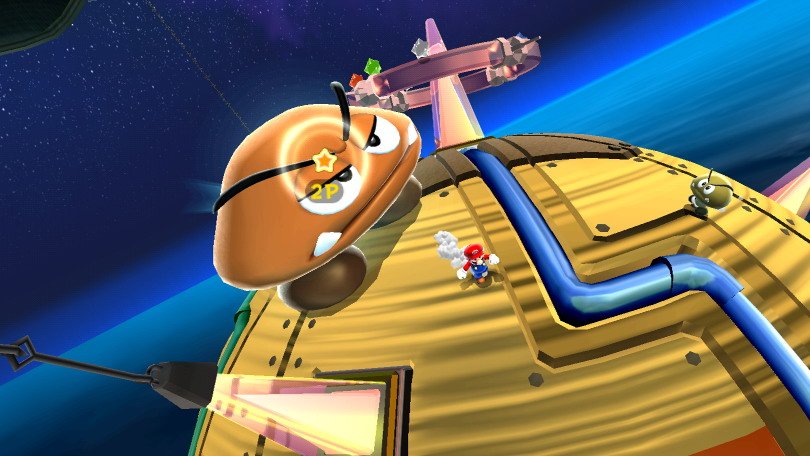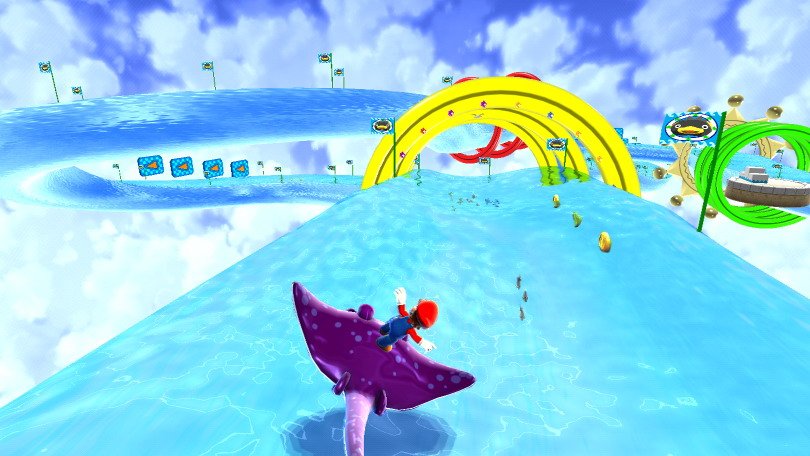Super Mario Galaxy Hands-On - The Early Galaxies
The famed plumber's colorful interstellar romp is almost here, and we took the game for a spin right from the beginning.
It's been over a decade since Super Mario 64 revolutionized the platforming genre with its seamless move into 3D space, and for his next trick, Nintendo's lovable plumber will blast off into outer space on the Wii. Super Mario Galaxy is nearing completion, and Nintendo was kind enough to let us take the game's reins right from the beginning. In case you were wondering how Mario has ended up in space this time around, you probably won't be surprised to find out it has something to do with Bowser kidnapping Princess Peach. Yes, again. The nefarious koopa has done one better this time, though, spiriting not only Peach but also her entire castle to the heavens. Mario will have to join forces with a mysterious celestial keeper named Rosalina and a quirky race of starlike interstellar beings called lumas in order to bring Peach and her kingdom safely back home.
You'll start out in the comet observatory, a hub level that functions much like Mario 64's castle, from which all of Galaxy's action levels (called galaxies, natch) branch out. The catch is, most of the observatory is experiencing a blackout, and the areas that lack power are literally dark at the game's outset. As you collect stars over the course of the game, you'll gradually restore power to each section of the platform and thus gain access to new galaxies. Luckily, the small portion of the observatory that is functioning is alive with color and activity. When you start out, the first dome--that is, a small building within the observatory that will let you look at and then travel to unlocked galaxies--is already online and ready to launch you to places like the Good Egg Galaxy and the Honeybee Galaxy, which are the two earliest areas of the game and which Nintendo has shown off rather liberally in past demos. When you enter a dome, the game will show you a star-map interface depicting the orbital patterns of the various galaxies you can access from that dome. You can click and drag with the Wii Remote to rotate the map around, and then launch to a new galaxy simply by clicking on it.

To power up new areas of the observatory and then get to new galaxies, you'll need stars. Lots of stars! As per Mario tradition, Galaxy will have 120 stars for you to collect, and you'll revisit most galaxies several times to find multiple stars that require you to complete different tasks to obtain. In Mario 64, for example, each level had seven stars, so it was easy to chart your overall progress through the game by seeing how many stars you'd collected per level. But Galaxy's star distribution seems less strictly regimented than past Mario games. For instance, the first couple of galaxies we played had three stars each. But then we moved on to a racing-focused minigalaxy that had only one star available, with no obvious chance to pick up more stars later. That racing level consisted of a giant water flume suspended in midair seemingly by nothing at all. We were able to race down the course by holding the A button to accelerate, and we had to steer solely by twisting the Wii Remote on its axis (that is, twist left to steer left, right to go right).
Even with only an hour to play Mario Galaxy, we were amazed by the wide range of gameplay mechanics and lush visuals on offer. In the Space Junk Galaxy, we had to traverse a series of platforms constantly being assembled and disassembled beneath our feet. This section also featured several areas where Mario escaped the tenuous gravity of the junk planetoid and drifted along in a little space bubble. Our only means of controlling him at this point was to use the pointer to click on a number of nearby stars. Each star, when clicked, would shoot out a little beam and grab onto Mario, pulling him in. So it was possible to make use of the floaty mechanics here by clicking on a number of the stars rapidly in sequence to slingshot Mario along to his next destination.
Later on, we had to tackle a boss battle against one of Bowser Jr.'s enormous robots. This thing was basically just a big head with gigantic legs coming out of it, and we had to start out at its feet and slowly inch our way up to the body as it stomped its way around a little planet. Once we approached the head, we had to maneuver between a bunch of cannons shooting bullet bills at us. These bullets actually came in handy since they would follow us around wherever we ran. We simply had to get one to fire at us, lead the bullet toward the robot's nerve center, and then duck out of the way just in time for the bullet to blow a hole in the bot brain. Defeating this boss gave us a "grand star," which we quickly discovered will restore power to a new section of the observatory, letting you explore more new galaxies.

Every level of the game we saw had its own unique aesthetic and graphical elements that made it wholly distinctive from the others. The game is basically a feast for the eyes--each galaxy is absolutely popping with bright, saturated colors and day-glo lighting effects. Even though Mario Galaxy only runs in 480p resolution (like all Wii games), Nintendo's artists have done a fabulous job of compensating for the relative lack of detail with lush, colorful, highly detailed artwork.
From the first hour we played, Super Mario Galaxy seems like a great mix of tried-and-true 3D Mario mechanics--butt-stomping, spin-attacking, coin collecting--with some less orthodox gameplay. The game plays fast and loose with concepts like gravity and orientation, as befits the outer-space setting, and we can't wait to see what kind of craziness the designers have added to the later areas of the game.
Got a news tip or want to contact us directly? Email news@gamespot.com
Join the conversation